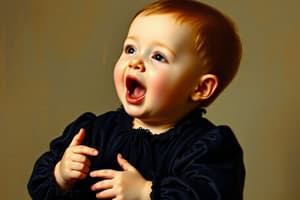Podcast
Questions and Answers
At what age does a baby typically start 'babbling'?
At what age does a baby typically start 'babbling'?
- Immediately after birth
- Around one year
- Around three to four months (correct)
- Around six weeks
What does recent research suggest about newborn babies' cries?
What does recent research suggest about newborn babies' cries?
- They follow the intonations of the languages babies heard in the womb (correct)
- They are completely random and unrelated to language
- They are not language-specific
- They are solely determined by the baby's immediate needs
What purpose do the sounds made by infants during the babbling stage serve?
What purpose do the sounds made by infants during the babbling stage serve?
- To practice producing unrelated sounds
- To communicate their immediate needs
- To prepare them for word production later on (correct)
- To imitate adult speech
What is the purpose of caretaker language during the babbling stage?
What is the purpose of caretaker language during the babbling stage?
What is 'reduplication' in the context of infant language development?
What is 'reduplication' in the context of infant language development?
Why is the style of caretaker language considered distinctive?
Why is the style of caretaker language considered distinctive?
How does babbling to parents or carers benefit the baby?
How does babbling to parents or carers benefit the baby?
Newborn infants' cries have been proven to be language-specific according to a German study in 2009.
Newborn infants' cries have been proven to be language-specific according to a German study in 2009.
What is one way in which babies typically respond to caretaker language?
What is one way in which babies typically respond to caretaker language?
Babbling serves no purpose in the development of conversational skills in infants.
Babbling serves no purpose in the development of conversational skills in infants.
The baby's first smile usually occurs around three to four months of age.
The baby's first smile usually occurs around three to four months of age.
During the babbling stage, parents and family do not contribute to the child's development by speaking to them.
During the babbling stage, parents and family do not contribute to the child's development by speaking to them.
During the babbling stage, infants produce sounds that are directly related to the language they will speak later on.
During the babbling stage, infants produce sounds that are directly related to the language they will speak later on.
Caretaker language is characterized by a lower and more serious tone compared to normal speech.
Caretaker language is characterized by a lower and more serious tone compared to normal speech.
Infants respond to caretaker language by imitating complex words and sentences.
Infants respond to caretaker language by imitating complex words and sentences.
Caretaker language during the babbling stage is considered distinctive due to its syllable-like sequences.
Caretaker language during the babbling stage is considered distinctive due to its syllable-like sequences.
Flashcards are hidden until you start studying




